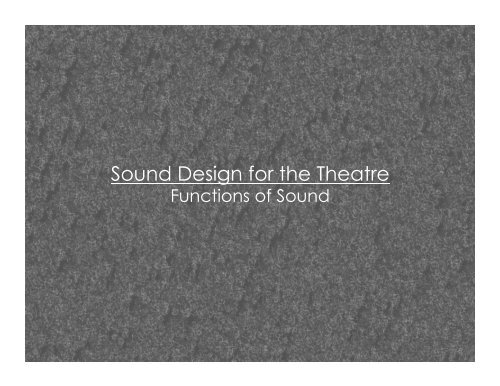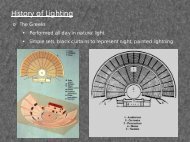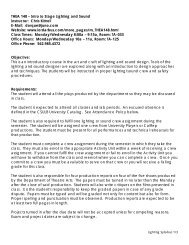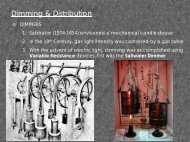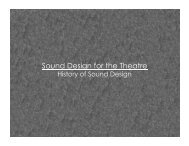Sound Design for the Theatre
Sound Design for the Theatre
Sound Design for the Theatre
Create successful ePaper yourself
Turn your PDF publications into a flip-book with our unique Google optimized e-Paper software.
<strong>Sound</strong> <strong>Design</strong> <strong>for</strong> <strong>the</strong> <strong>Theatre</strong><br />
Functions of <strong>Sound</strong>
Functions of <strong>Sound</strong> in <strong>the</strong> <strong>Theatre</strong><br />
o Functions and Conventions of <strong>Sound</strong><br />
1. Acoustic – ability to hear <strong>the</strong> actor<br />
2. Rein<strong>for</strong>cement – amplify <strong>the</strong> actor, singer, orchestra <strong>for</strong> audibility<br />
3. Atmosphere – or ambience, creates mood or aural environment<br />
4. Framing – Preshow, Intermission and Curtain Call effects and music,<br />
can establish time period, location, mood and style<br />
5. Transition – Bridge scenes, suggest changes of time or location<br />
6. Underscore – rein<strong>for</strong>ces psychological content of moments, not<br />
‘heard’ by <strong>the</strong> actors, may function as a leitmotif or <strong>the</strong>me<br />
7. Spot Effects – momentary sounds to highlight a specific moment,<br />
can be practical (phones, thunderclaps) or stylistic<br />
8. Featured Music – program music in an opera or musical or music<br />
required by <strong>the</strong> script, may follow any of <strong>the</strong> above conventions<br />
9. Voice Over – recorded speech, represents thoughts or presents info
Functions of <strong>Sound</strong> in <strong>the</strong> <strong>Theatre</strong><br />
o Aspects of <strong>Sound</strong> Cues<br />
1. Volume<br />
2. Fade – change of volume, includes time to complete change<br />
3. Focus – relation of <strong>the</strong> cue to <strong>the</strong> action, voices and environment<br />
4. Mix – relation of separate sound elements in a cue<br />
5. EQ – Equalization, altering <strong>the</strong> frequencies present<br />
6. Location – where <strong>the</strong> sound comes from, speaker location<br />
7. Movement – <strong>the</strong> transition of a sound between locations<br />
8. Cueing – placement of <strong>the</strong> cue in <strong>the</strong> script or score
Functions of <strong>Sound</strong> in <strong>the</strong> <strong>Theatre</strong><br />
o The Intent of <strong>Sound</strong> Cues<br />
1. Why is <strong>the</strong> cue <strong>the</strong>re, what is its function?<br />
2. Is <strong>the</strong> sound associated with a particular character?<br />
3. What is <strong>the</strong> psychological intent?<br />
4. What is <strong>the</strong> period, time and location?<br />
5. Interaction with <strong>the</strong> actors and <strong>the</strong> world of <strong>the</strong> play<br />
6. Rein<strong>for</strong>ce <strong>the</strong> action onstage<br />
7. Illustrate and support emotion<br />
8. Create focus<br />
9. Dramaturgy – Leitmotif and <strong>for</strong>eshadowing
Functions of <strong>Sound</strong> in <strong>the</strong> <strong>Theatre</strong><br />
o Styles of <strong>Sound</strong> <strong>Design</strong><br />
1. Realistic – sounds function as close to reality as possible<br />
Strong attention paid to factual detail, toilet flushes, music from<br />
practical (functioning) radios, phone rings; clearly represent reality<br />
May use preshow and intermission music, but little underscore<br />
2. Cinematic – variation on realism<br />
Extensive use of ambience and environment, very detailed<br />
Involved musical underscoring, leitmotifs <strong>for</strong> characters<br />
3. Representational – sparser <strong>for</strong>m of cinematic realism<br />
Environments introduce scene and <strong>the</strong>n fade out or<br />
use single element to establish locale<br />
Music is more specifically used
Functions of <strong>Sound</strong> in <strong>the</strong> <strong>Theatre</strong><br />
o Styles of <strong>Sound</strong> <strong>Design</strong><br />
3. Representational – sparser <strong>for</strong>m of cinematic realism<br />
Environments introduce scene and <strong>the</strong>n fade out or<br />
use single element to establish locale<br />
Music is more specifically used<br />
4. Abstract – sounds reflect <strong>the</strong> artist’s interpretation of <strong>the</strong> world<br />
Can be impressionistic or expressionistic, design is conceptualized<br />
<strong>Sound</strong>s are distorted, unnatural or used in a different context<br />
5. Absurd – elements are incongruous or surreal


